McDowell’s Garage
Friday, September 19th, 2008 McDowell’s Garage at 2650 North High Street. (Photocopy courtesy of Frank Jones.)
McDowell’s Garage at 2650 North High Street. (Photocopy courtesy of Frank Jones.)
 McDowell’s Garage at 2650 North High Street. (Photocopy courtesy of Frank Jones.)
McDowell’s Garage at 2650 North High Street. (Photocopy courtesy of Frank Jones.)
 A wonderful picture of the Weisheimer Mill including the Jacob Weisheimer home (which still exists) and other buildings at the mill complex. The photographer would be looking north up Starrett Road to Weisheimer Road. You can click on this image to see the distant details. I show some other images of the mill and Weisheimer homes on pages 21-22 of my book. (Photo courtesy of the Columbus Metropolitan Library.)
A wonderful picture of the Weisheimer Mill including the Jacob Weisheimer home (which still exists) and other buildings at the mill complex. The photographer would be looking north up Starrett Road to Weisheimer Road. You can click on this image to see the distant details. I show some other images of the mill and Weisheimer homes on pages 21-22 of my book. (Photo courtesy of the Columbus Metropolitan Library.)
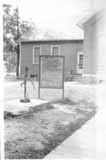 The old brick school house which became the foundational building of Maple Grove Church was originally built in 1878. The church was organized around 1919, and began meeting in the abandoned school around 1920. In 1923 a frame addition was dedicated and this served as their parish hall for many years. In 1929 the lot was further expanded, and a campaign for new construction began shortly thereafter. (Photo courtesy of the Maple Grove Methodist Church)
The old brick school house which became the foundational building of Maple Grove Church was originally built in 1878. The church was organized around 1919, and began meeting in the abandoned school around 1920. In 1923 a frame addition was dedicated and this served as their parish hall for many years. In 1929 the lot was further expanded, and a campaign for new construction began shortly thereafter. (Photo courtesy of the Maple Grove Methodist Church)
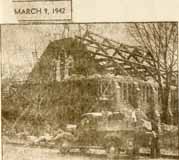 The cornerstone was laid on Pearl Harbor Day in 1941. A stop light was installed at the corner of Henderson and High in 1940—a real sign of growth and “progress.”
The cornerstone was laid on Pearl Harbor Day in 1941. A stop light was installed at the corner of Henderson and High in 1940—a real sign of growth and “progress.”
(Photo courtesy of the Maple Grove Methodist Church)
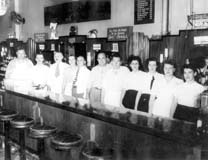 Metzger’s Grill was located at 2571 North High Street. The photos were taken in 1948. Employees (left to right) were Thurm Buckholtz, Bob Grady, ?, Min Metzger, Charley Redd, Jim Walker, ?, ?, Erma Young, Ruth Thomas, Opal Holly.
Metzger’s Grill was located at 2571 North High Street. The photos were taken in 1948. Employees (left to right) were Thurm Buckholtz, Bob Grady, ?, Min Metzger, Charley Redd, Jim Walker, ?, ?, Erma Young, Ruth Thomas, Opal Holly.
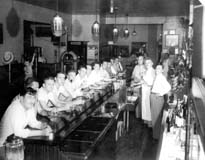 Some customers at the grill, front to back: #8 Ruth Thomas, #10 Eddie Thomas, #12 Thurm Buckholtz, #13 Doc Sly. Behind the bar: Charley Redd, Harvey Edgar, Jim Walker, Min Metzger.
Some customers at the grill, front to back: #8 Ruth Thomas, #10 Eddie Thomas, #12 Thurm Buckholtz, #13 Doc Sly. Behind the bar: Charley Redd, Harvey Edgar, Jim Walker, Min Metzger.
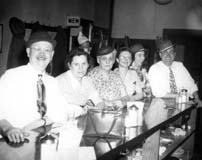 Here’s a picture of Harvey Edgar, ?, Ma Berwill, ?, Min Metzger, Jim Walker. (Photos courtesy of Frank Jones.)
Here’s a picture of Harvey Edgar, ?, Ma Berwill, ?, Min Metzger, Jim Walker. (Photos courtesy of Frank Jones.)
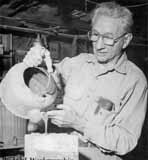 Here’s a very nice Columbus Dispatch article about Chester Nicodemus.
Here’s a very nice Columbus Dispatch article about Chester Nicodemus.
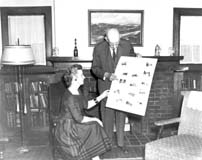
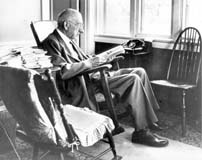
A. B. Graham (Albert Belmont Graham) was an educator from Springfield OH. He had an idea: to get young people together to learn about agriculture and develop skills for farm living. He formed an organization to enable such practical learning. He originally called it the Boys and Girls Experimental Club, and then, the Boys and Girls Agricultural Club. By 1905 there were over 2,000 young people in sixteen Ohio counties participating in Agricultural Clubs. Graham was named Superintendent of Extension of the Ohio Cooperative Extension Service and the clubs were expanded nationwide. In 1916 the Boys and Girls Clubs officially became the 4-H Clubs.
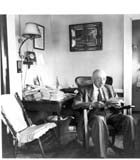 A.B. Graham eventually worked for the USDA in Washington DC. After his retirement in 1938 he moved back to Columbus. He lived in his home on Clinton Heights Avenue until his death at the age of 91 in January 14, 1960. These photos show him at his Clintonville home. Happily, today I live in that very same house.
A.B. Graham eventually worked for the USDA in Washington DC. After his retirement in 1938 he moved back to Columbus. He lived in his home on Clinton Heights Avenue until his death at the age of 91 in January 14, 1960. These photos show him at his Clintonville home. Happily, today I live in that very same house.
What do the 4 H’s stand for? Well, originally, there were only 3 H’s and the insignia was a 3-leafed clover. The H’s stood for head, hearts, hands. Then a 4th H was added and the organization’s clover became 4-leafed. That last H stood for hustle. But “hustle” didn’t stand up to the test of time and was eventually replaced by a tamer “H,” that is, health.
(Photos courtesy of OSU Photo Archives, Drawer #213.)
In the summer of 1912, a book agent promoted an 11-volume set of books entitled The Foundation for Young People. Buyers were entitled to a Certificate of Membership in the Child Welfare League of America. Twenty-five local women pledged, and 11 of them came to the first local meeting. In the early days they met in the guild room of Saint James Episcopal Church. They held readings and had discussions on predetermined topics. They supported Columbus’ Baby Camp; they held Minstrel shows to benefit the Belgian Relief Fund; they sponsored a hot lunch program in the local schools. Clintonville was outside the city limits in these early days and had no city library service, and so club members established a branch of the state library within Clinton School from 1914-1915, and when that was deemed impractical, they had a lending library at Cummings Drugstore located at Clinton Heights Avenue and North High Street—another idea that proved to be impractical. Eventually a Columbus Public Library 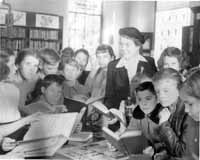 branch was put into Clintonville, and when the local group became aware of the local library’s need for books, they held a “book shower” to bring in book donations. They engaged in war relief work in 1917. They advocated getting rid of some dirty carriage sheds at the Clinton school. In 1915 they were also able to convert two vacant lots owned by J. E. Pierson on Dunedin near Beach Hill Avenue (now Calumet Street) for use as community tennis courts. The club contributed to the community through World War I, the flu epidemic of 1918, the Great Depression, World War II, the Korean War, and the Vietnam War. Over the years their name changed from Clinton Child Welfare League to the Clinton Social Welfare League (1913) to the Clinton Welfare League (1915) to the Clinton League (1925). The group disbanded around 1977. Their papers can be read on microfilm at the Ohio Historical Society.
branch was put into Clintonville, and when the local group became aware of the local library’s need for books, they held a “book shower” to bring in book donations. They engaged in war relief work in 1917. They advocated getting rid of some dirty carriage sheds at the Clinton school. In 1915 they were also able to convert two vacant lots owned by J. E. Pierson on Dunedin near Beach Hill Avenue (now Calumet Street) for use as community tennis courts. The club contributed to the community through World War I, the flu epidemic of 1918, the Great Depression, World War II, the Korean War, and the Vietnam War. Over the years their name changed from Clinton Child Welfare League to the Clinton Social Welfare League (1913) to the Clinton Welfare League (1915) to the Clinton League (1925). The group disbanded around 1977. Their papers can be read on microfilm at the Ohio Historical Society.
From 1945 to 1953, they donated books to the Clintonville Library. In this photograph, Mrs. Miller presents books to the children at the Clintonville Library, on behalf of the Clinton League. (Photo courtesy of the Clintonville Historical Society)

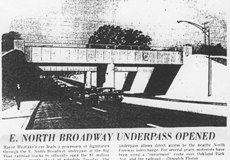
For the residents of East North Broadway, widening their roadway has been a seemingly endless struggle of defending their property against City Hall. Joyce Schatz–for many years an officer in the East North Broadway Street Association–has kept an archive of the issue, and I’ve linked to it here.
The city claims the right of way is 100 feet. Some research shows that it is 70 feet. Residents’ deeds and surveys are all over the place. Some have 15’ listed, many don’t, including recent purchasers. The majority of the parcels at the end of the street do not have the 15’ easement in their deeds. The deed to Steve and Ann Wilson’s home (one of the three slated to lose their yard), specifically includes the footage and states “…Together with the Fifteen (15) feet off the North Side of East North Broadway vacated by resolution of the County Commissioners of Franklin County, Ohio, on October 7, 1952.”
For those of us who don’t live on East North Broadway, the issue is less “Can the City do it?” but “Should the City do it?’ For the time being, the city is not actively pursuing the widening.
 In addition to compiling a list of Clintonville’s “notable people,” I have often wanted to see a list of Clintonville art and artists. My list might include:
In addition to compiling a list of Clintonville’s “notable people,” I have often wanted to see a list of Clintonville art and artists. My list might include:
Jodi Kushins, artist of Smith’s Deli external mural
Smith’s Deli’s indoor murals as well
Chad Bender (children books)
Jerry Devine (chain saw art, out of Como Mower Service & Sales on Indianola)
Harlow Ballard (digital art)
Tim George (Etch-a-Sketch artist)
Chester Nicodemus (ceramics)
Mac O. Shaffer (photographer)
Fred Shannon (photographer)
Mathias Armbruster
Art in Clintonville churches
Marlo Bartels’ Skyline mural formerly at Clinton Elementary School
Please add to my list in the Comments below!